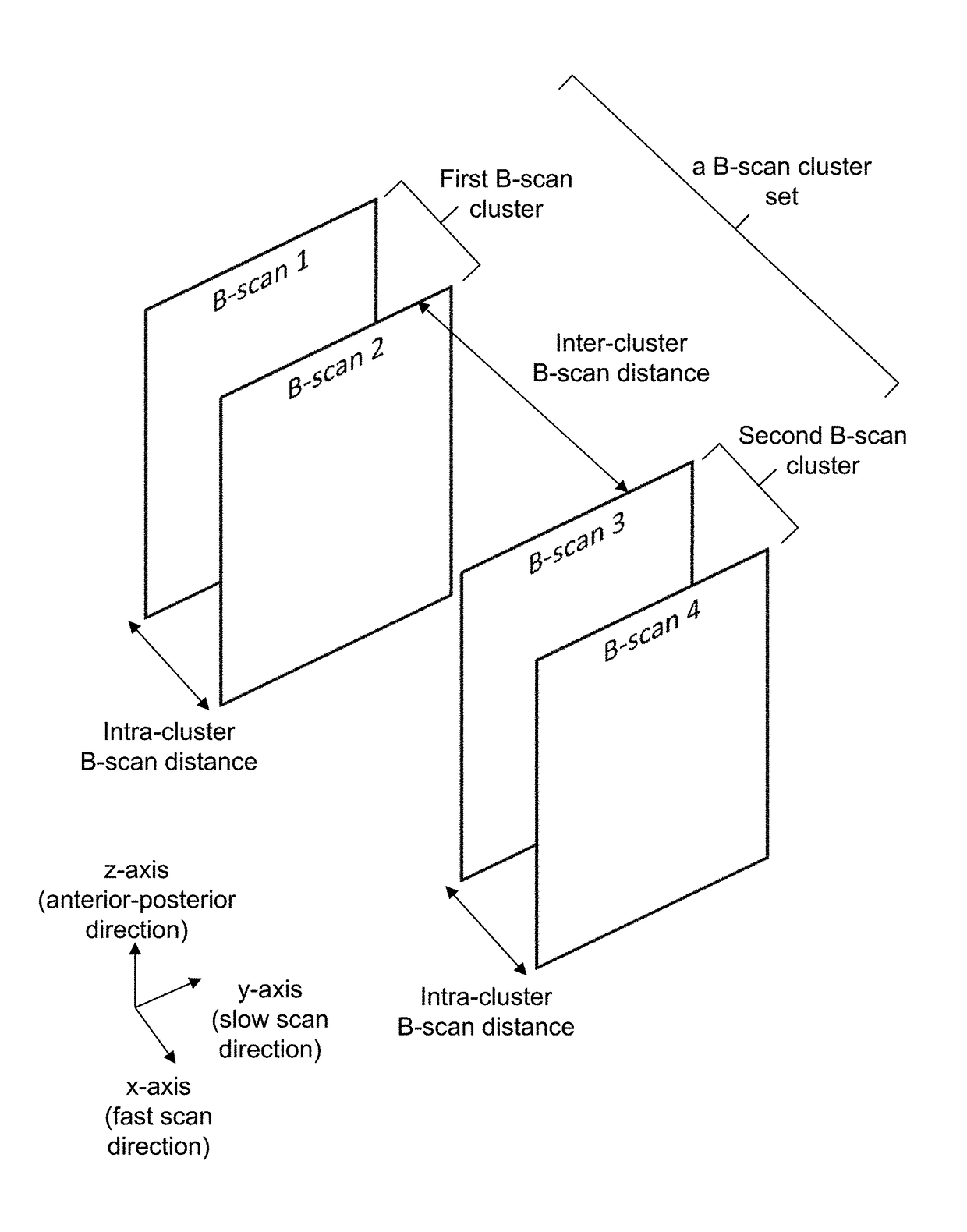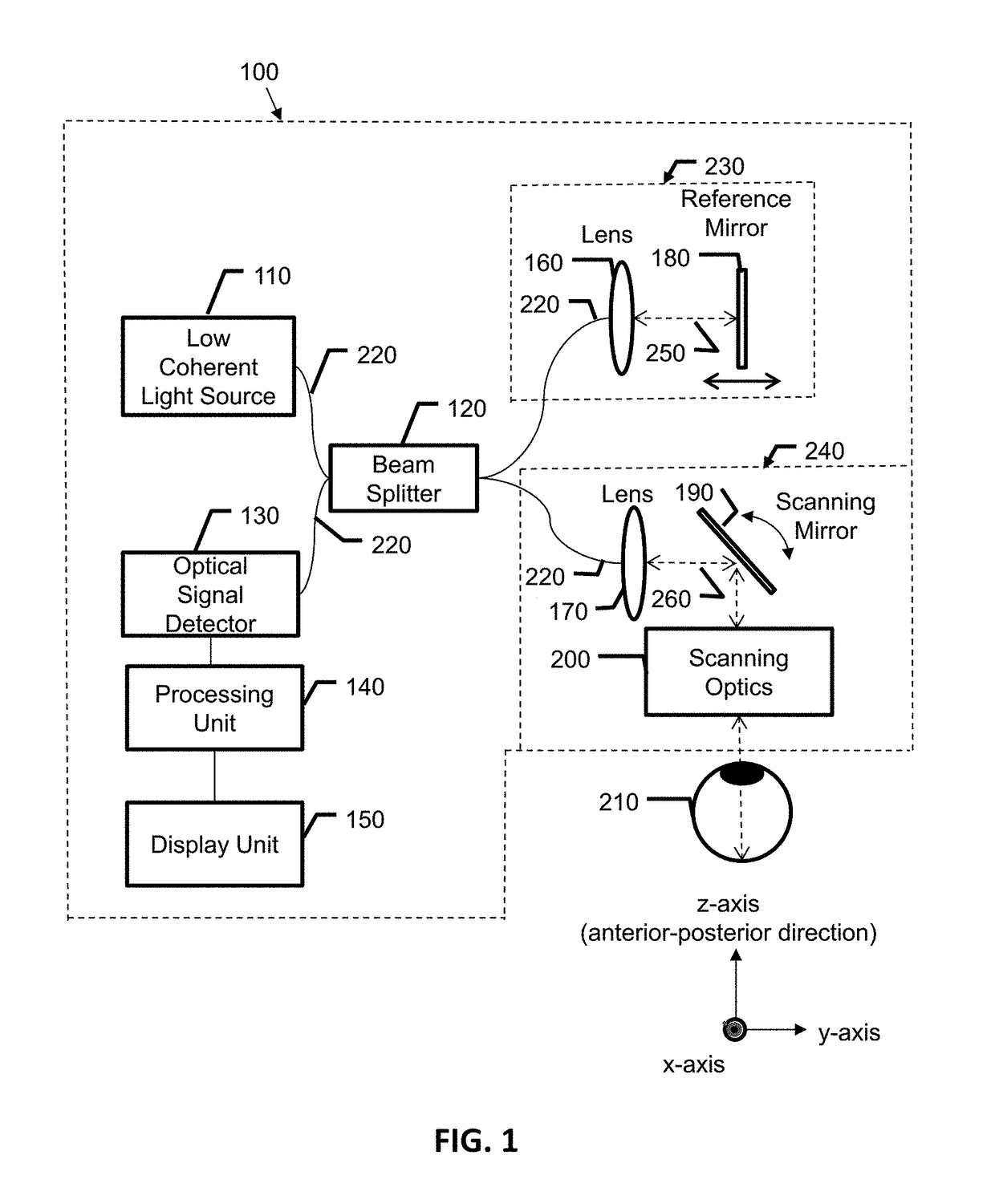Optical coherence tomography (OCT) system with improved motion contrast
a coherence tomography and optical coherence technology, applied in the field of optical coherence tomography, can solve the problems of limited technique, slowest motions become obscured by noise, and current oct technology may not provide adequate visualization of retinal and choroidal microvasculature, so as to reduce the effect of at least one noisy b-scan cluster and one or more noisy data effects
- Summary
- Abstract
- Description
- Claims
- Application Information
AI Technical Summary
Benefits of technology
Problems solved by technology
Method used
Image
Examples
example 1
-Scan Cluster Set Comprising Two B-Scan Clusters to Enhance OCT Motion Contrast
[0106]In this example, PV-OCT method is used as the OCT motion contrast method. The phase difference between B-scans is used to calculate the statistical variance for the motion contrast. The data is acquired from two neighboring B-scan clusters, each comprising 4 B-scans. That is, there are two B-scan clusters within each B-scan cluster. Three phase changes are calculated for each B-scan cluster, with a total of 6 phase changes for the B-scan cluster set. The phase variance thus calculated is assigned to one of the neighboring pairs of the B-scans.
[0107]Typical methods would only calculate contrast from within each B-scan cluster. To achieve the same number of statistics of 6 phase changes would require 7 B-scans for each B-scan cluster, in comparison to the 4 B-scans required in this example.
[0108]Exemplary OCT images of a retinal vasculature formed by using the OCT motion contrast method disclosed in t...
example 2
Complete B-Scan Cluster of Data and a Fraction of the Data from a Neighboring Cluster
[0110]In this example, PV-OCT method is used as the OCT motion contrast method. The phase difference between B-scans is used to calculate the statistical variance for image contrast. The data is acquired to form two neighboring B-scan clusters, each comprising 4 B-scans. Three phase changes are calculated for one B-scan cluster and two phase changes are calculated for the other B-scan cluster. Thus, there are a total of 5 phase changes for the B-scan cluster set. The phase variance thus calculated is assigned to one of the neighboring pairs of the B-scans.
[0111]In this example, not all B-scans in each cluster are used in the phase change calculations, although they are acquired for each cluster. This exemplary method reduces calculation time for the phase variance by a factor of 6 / 5 as compared to that disclosed in Example 1.
[0112]Thus, the imaging speed may further be increased by using every B-sca...
example 3
[0113]In this example, the intensity variance is calculated to form an OCT image. Typical intensity variance imaging methods may require a minimum of 4 B-scans in each B-scan cluster to perform 3 phase change calculations.
[0114]However, in the OCT motion contrast method, a B-scan cluster set comprising two B-scan clusters comprising three B-scans per B-scan cluster may provide similar OCT motion contrast as follows. In this example, since each B-scan cluster provides 2 phase change calculations, there are total of 4 phase change calculations available for outlier analysis and motion contrast calculations. Thus, the required number of B-scans per cluster may be reduced from 4 to 3 by using the OCT motion contrast method disclosed above.
PUM
 Login to View More
Login to View More Abstract
Description
Claims
Application Information
 Login to View More
Login to View More - R&D
- Intellectual Property
- Life Sciences
- Materials
- Tech Scout
- Unparalleled Data Quality
- Higher Quality Content
- 60% Fewer Hallucinations
Browse by: Latest US Patents, China's latest patents, Technical Efficacy Thesaurus, Application Domain, Technology Topic, Popular Technical Reports.
© 2025 PatSnap. All rights reserved.Legal|Privacy policy|Modern Slavery Act Transparency Statement|Sitemap|About US| Contact US: help@patsnap.com



